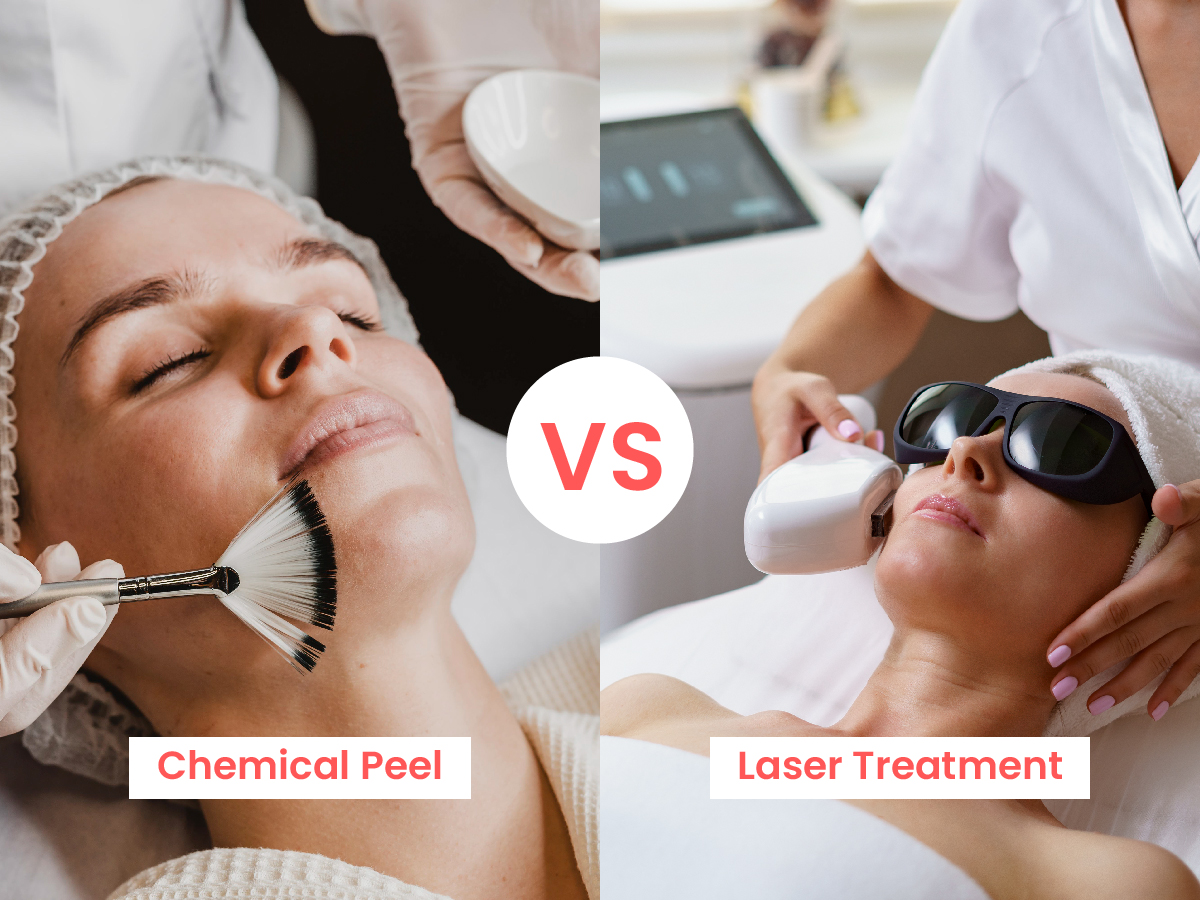
-
Posted By drruby.Sachdev@gmail.com
-
-
Comments 0
Table of Contents
Introduction
Achieving healthy, radiant skin is a common goal, and advanced skincare treatments like chemical peel treatment and laser treatment have become increasingly popular in India. These treatments offer significant improvements for various skin concerns but choosing the best one can be challenging. This blog will compare chemical peel treatment and laser treatment to help you make an informed decision.
What is a Chemical Peel?
A chemical peel treatment involves applying a chemical solution to the skin to exfoliate and peel off the top layers. This process reveals newer, smoother, and clearer skin beneath. Chemical peel treatment is used to treat issues such as acne scars, pigmentation, fine lines, and sun damage. The depth of the peel can vary from light to deep, depending on the skin issue being addressed.
Revitalize Your Skin with a Chemical Peel
Discover the transformative power of Chemical Peel Treatment in Bangalore at Skinnfit Medspa Clinic. Under the expert care of Dr. Ruby Sachdev, achieve smoother, brighter, and rejuvenated skin. Book your appointment today for professional and personalized skincare solutions!
What is Laser Treatment?
Laser treatment uses focused beams of light to penetrate the skin layers, stimulating collagen production and promoting cell regeneration. This treatment helps reduce wrinkles, scars, and pigmentation. Laser treatment is highly customizable and can target a wide range of skin concerns.
Chemical Peel vs Laser Treatment
Treatment Process: In a chemical peel treatment, a chemical solution is applied to the skin’s surface. The solution stays on the skin for a specified time before being neutralized and removed. The intensity of the peel can be adjusted based on the desired results.
During a laser treatment, a laser device emits focused light beams that penetrate the skin. The laser targets specific skin issues, such as wrinkles or pigmentation. The intensity and type of laser can be customized according to the patient’s needs.
Effectiveness: Chemical peel treatment is effective for surface-level skin issues, such as mild acne scars, hyperpigmentation, and fine lines. It helps achieve a more even skin tone and smoother texture.
Laser treatment is generally more effective for deeper skin concerns, including significant wrinkles, deep scars, and extensive pigmentation issues. The results of laser treatment are often more dramatic and long-lasting.
Downtime and Recovery: Recovery time for a chemical peel treatment depends on the depth of the peel. Light peels may have minimal downtime, while deeper peels can require several days to a week for full recovery.
The recovery period for laser treatment varies based on the type of laser used. Non-ablative lasers have minimal downtime, while ablative lasers may need a longer recovery period, ranging from a few days to a couple of weeks.
Pain & Discomfort: During a chemical peel treatment, patients may experience a tingling or burning sensation, which subsides once the chemical solution is neutralized.
Laser treatment can cause discomfort, often described as a snapping sensation on the skin. Topical anesthetics are typically used to minimize pain during the procedure.
Cost Comparison: Chemical peel treatment is generally more affordable compared to laser treatment. The cost depends on the depth of the peel and the number of sessions required.
Laser treatment tends to be more expensive due to the advanced technology and equipment involved. However, the long-term results of laser treatment often justify the higher cost, especially for more severe skin concerns.
Skin Type and Suitability: Chemical peel treatment is suitable for most skin types but requires careful consideration for darker skin tones to avoid hyperpigmentation. Consulting with a dermatologist is essential to determine the appropriate peel strength.
Laser treatment is highly customizable, making it suitable for a wide range of skin types and concerns. However, individuals with very dark skin tones should consult a dermatologist to ensure the treatment is safe and effective.
Long-Term Results and Maintenance: Chemical peel treatment offers significant improvements in skin texture and tone, with results lasting several months. Regular maintenance treatments can help sustain these benefits.
Laser treatment provides long-lasting results, particularly for deep scars and wrinkles. Periodic maintenance sessions can help preserve the improvements achieved.
Why Choose Skinnfit Medspa for Chemical Peel Treatment and
Laser Treatment?
At Skinnfit Medspa, we prioritize safety and efficacy in all our treatments. Our experienced team, led by Dr. Ruby Sachdev, ensures that both chemical peel treatment and laser treatment are tailored to meet your unique skin needs. We use the latest technology and follow stringent safety protocols to deliver the best results.
Explore Skin Treatments at SkinnFit Medspa in Bangalore By Dr. Ruby Sachdev
Dr. Ruby Sachdev at SkinnFit Medspa offers a range of advanced skin treatments, including chemical peel treatment and laser treatment. Whether you’re dealing with acne scars, pigmentation, or fine lines, our customized treatment plans are designed to enhance your skin’s health and appearance.
Conclusion
Both chemical peel treatment and laser treatment offer significant benefits for various skin concerns. The best treatment for you depends on your specific skin issues, budget, and desired results. Consulting with a qualified dermatologist at Skinnfit Medspa can help you determine the most suitable option for your skin.
Frequently Asked Questions
At Skinnfit Medspa, we adhere to strict safety protocols and use the latest technology to ensure safe and effective chemical peel treatment and laser treatment. Our experienced team tailors each treatment to the patient’s specific needs.
Both chemical peel treatment and laser treatment can effectively reduce acne scars. However, laser treatment is generally more effective for deeper scars, while chemical peel treatment is suitable for mild to moderate scars.
The number of sessions varies based on the individual’s skin condition and treatment goals. Generally, multiple sessions are required for optimal results in both chemical peel treatment and laser treatment.
Laser treatment is often more effective for treating deep pigmentation issues like melasma and sunspots. However, chemical peel treatment can also provide significant improvement for surface-level pigmentation.
After a chemical peel treatment, it is advisable to wait until the skin has fully healed before applying makeup. For laser treatment, the wait time can vary, but generally, it is best to avoid makeup for a few days post-treatment to allow the skin to recover fully.



